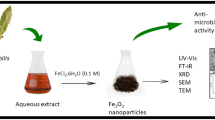Abstract
Metal nanoparticles are being progressively employed in several industrial sectors, and there are a growing interest and demand to develop and standardize more environmentally safe and biocompatible procedures for their synthesis. Thus, green technology has emerged as the best eco-friendly way for the synthesis of the metallic nanoparticle. The study is about plant extract-mediated green synthesis of iron oxide nanoparticles. Extract of Lawsonia inermis (Henna) was used for reduction of ferrous sulfate salt to iron oxide nanoparticles. These nanoparticles were functionalized with l-tyrosine. The biosynthetically synthesized iron oxide nanoparticles were characterized by UV–visible spectroscopy, Fourier transform infrared spectroscopy (FT-IR), scanning electron microscope and energy-dispersive X-ray spectrometer, and the results confirmed the synthesis of l-tyrosine-coated iron oxide nanoparticles. The UV–visible spectroscopy analysis confirmed the formation of nanoparticles formation indicated the surface plasmon resonance at a maximum wavelength of 224 nm. Morphology and shape of the nanoparticles were analyzed by SEM, and the result demonstrates that the particles are spherical in shape with an average size of 150–200 nm. Major functional groups present and involved in the conjugation of l-tyrosine on the surface of iron oxide nanoparticles were analyzed from FT-IR, and the results indicated that the l-tyrosine binds with O–H group of iron oxide nanoparticle to form a conjugate. The parameters were optimized by monitoring the effect of different parameters like concentration of salt, pH, temperature and reducing agent. The optimum nanoparticle synthesis parameters were found to be 0.02 M of FeSO4 concentration, 11 pH, 60 °C temperature and 4 g of reducing agent concentration. Antimicrobial activity of l-tyrosine and bare iron oxide nanoparticles were performed by well diffusion method against two pathogenic bacterial strains Staphylococcus aureus and Staphylococcus typhimurium. The positive results were observed against both S. aureus and S. typhimurium in case of l-tyrosine-functionalized iron oxide nanoparticles with an average inhibition zone of 1.6 and 1.5 cm, respectively. This indicates that the functionalized nanoparticles have great potential as an antimicrobial compound. The surface modification has increased the effectiveness of the iron oxide nanoparticles as an antimicrobial compound that has not been reported in previous studies.








Similar content being viewed by others
References
Albrecht MA, Evans CW, Raston CL (2006) Green chemistry and the health implications of nanoparticles. Green Chem 8(5):417–432. https://doi.org/10.1039/b517131h
Rahman MM, Khan SB, Jamal A, Faisal M, Aisiri AM (2011) Iron oxide nanoparticles. Nanomaterials. https://doi.org/10.5772/27698
Sherwood J, Xu Y, Lovas K, Qin Y, Bao Y (2017) Surface functionalization of dopamine coated iron oxide nanoparticles for various surface functionalities. J Magn Magn Mater 427:220–224. https://doi.org/10.1016/j.jmmm.2016.10.039
Wu W, Wu Z, Yu T, Jiang C, Kim WS (2015) Recent progress on magnetic iron oxide nanoparticles: synthesis, surface functional strategies and biomedical applications. Sci Technol Adv Mater 16(2):023501. https://doi.org/10.1088/1468-6996/16/2/023501
Joerger R, Klaus T, Granqvist CG (2000) Biologically produced silver-carbon composite materials for optically functional thin-film coatings. Adv Mater 12(6):407–409. https://doi.org/10.1002/(SICI)1521-4095(200003)12:6%3c407:AID-ADMA407%3e3.0.CO;2-O
Shankar SS, Ahmad A, Sastry M (2003) Geranium leaf assisted biosynthesis of silver nanoparticles. Biotechnol Prog 19(6):1627–1631. https://doi.org/10.1021/bp034070w
Logeswari P, Silambarasan S, Abraham J (2015) Synthesis of silver nanoparticles using plants extract and analysis of their antimicrobial property. J Saudi Chem Soc 19(3):311–317. https://doi.org/10.1016/j.jscs.2012.04.007
Khalil AT, Ovais M, Ullah I, Ali M, Shinwari ZK, Maaza M (2017) Biosynthesis of iron oxide (Fe2O3) nanoparticles via aqueous extracts of Sageretia thea (Osbeck) and their pharmacognostic properties. Green Chem Lett Rev. 10(4):186–201. https://doi.org/10.1080/17518253.2017.1339831
Saif S, Tahir A, Chen Y (2016) Green synthesis of iron nanoparticles and their environmental applications and implications. Nanomaterials 6(11):209. https://doi.org/10.3390/nano6110209
Rajiv P, Bavadharani B, Kumar MN, Vanathi P (2017) Synthesis and characterization of biogenic iron oxide nanoparticles using green chemistry approach and evaluating their biological activities. Biocatal Agric Biotechnol 12:45–49. https://doi.org/10.1016/j.bcab.2017.08.015
Kumar KS, Kathireswari P (2016) Biological synthesis of silver nanoparticles (Ag-NPS) by Lawsonia inermis (Henna) plant aqueous extract and its antimicrobial activity against human pathogens. Int J Curr Microbiol Appl Sci 5(3):926–937. https://doi.org/10.20546/ijcmas.2016.503.107
Rajendran SP, Sengodan K (2017) Synthesis and characterization of zinc oxide and iron oxide nanoparticles using Sesbania grandiflora leaf extract as reducing agent. J Nanosci. https://doi.org/10.1155/2017/8348507
Ismail RA, Sulaiman GM, Abdulrahman SA, Marzoog TR (2015) Antibacterial activity of magnetic iron oxide nanoparticles synthesized by laser ablation in liquid. Mater Sci Eng C 53:286–297. https://doi.org/10.1016/j.msec.2015.04.047
Kuppusamy P, Yusoff MM, Maniam GP, Govindan N (2016) Biosynthesis of metallic nanoparticles using plant derivatives and their new avenues in pharmacological applications—an updated report. Saudi Pharm J 24(4):473–484. https://doi.org/10.1016/j.jsps.2014.11.013
Khare CP (2008) Indian medicinal plants: an illustrated dictionary. Springer, Berlin. https://doi.org/10.1007/978-3-540-37418-3_4
Basavegowda N, Magar KB, Mishra K, Lee YR (2014) Green fabrication of ferromagnetic Fe3O4 nanoparticles and their novel catalytic applications for the synthesis of biologically interesting benzoxazinone and benzthioxazinone derivatives. New J Chem 38(11):5415–5420. https://doi.org/10.1039/C4NJ01155D
Stephen ZR, Dayringer CJ, Lim JJ, Revia RA, Halbert MV, Jeon M, Bakthavatsalam A, Ellenbogen RG, Zhang M (2016) Approach to rapid synthesis and functionalization of iron oxide nanoparticles for high gene transfection. ACS Appl Mater Interfaces 8(10):6320–6328. https://doi.org/10.1021/acsami.5b10883
Anyika C, Asri NAM, Majid ZA, Yahya A, Jaafar J (2017) Synthesis and characterization of magnetic activated carbon developed from palm kernel shells. Nanotechnol Environ Eng 2(1):16. https://doi.org/10.1007/s41204-017-0027-6
Wang T, Lin J, Chen Z, Megharaj M, Naidu R (2014) Green synthesized iron nanoparticles by green tea and eucalyptus leaves extracts used for removal of nitrate in aqueous solution. J Clean Prod 83:413–419. https://doi.org/10.1016/j.jclepro.2014.07.006
Makarov VV, Love AJ, Sinitsyna OV, Makarova SS, Yaminsky IV, Taliansky ME, Kalinina NO (2014) “Green” nanotechnologies: synthesis of metal nanoparticles using plants. Acta Nat 6:1–20
Mahdavi M, Ahmad MB, Haron MJ, Namvar F, Nadi B, Rahman MZ, Amin J (2013) Synthesis, surface modification and characterisation of biocompatible magnetic iron oxide nanoparticles for biomedical applications. Molecules 18(7):7533–7548. https://doi.org/10.3390/molecules18077533
Borcherding J, Baltrusaitis J, Chen H, Stebounova L, Wu CM, Rubasinghege G, Mudunkotuwa IA, Caraballo JC, Zabner J, Grassian VH, Comellas AP (2014) Iron oxide nanoparticles induce Pseudomonas aeruginosa growth, induce biofilm formation, and inhibit antimicrobial peptide function. Environ Sci Nano 1(2):123–132. https://doi.org/10.1039/C3EN00029J
Arakha M, Pal S, Samantarrai D, Panigrahi TK, Mallick BC, Pramanik K, Mallick B, Jha S (2015) Antimicrobial activity of iron oxide nanoparticle upon modulation of nanoparticle-bacteria interface. Sci Rep 5:14813. https://doi.org/10.1038/srep14813
Daima HK, Selvakannan PR, Homan Z, Bhargava SK, Bansal V (2011) Tyrosine mediated gold, silver and their alloy nanoparticles synthesis: antibacterial activity toward gram positive and gram negative bacterial strains. In Nanoscience, Technology and Societal Implications (NSTSI), 2011 International Conference, IEEE 1-6. https://doi.org/ 10.1109/NSTSI.2011.6111779
Author information
Authors and Affiliations
Corresponding author
Ethics declarations
Conflict of interests
None.
Ethical approval
The authors of this manuscript have followed all the terms and conditions of journal’s publication ethics. We would like to confirm that the manuscript has submitted solely to this journal. The manuscript has not been published previously (partly or in full), unless the new work concerns an expansion of previous work (please provide transparency on the re-use of material to avoid the hint of text-recycling (“self-plagiarism”)). A single study is not split up into several parts to increase the quantity of submissions and submitted to various journals or to one journal over time (e.g., “salami-publishing”). No data have been fabricated or manipulated (including images) to support your conclusions. No data, text or theories by others are presented as if they were the author’s own (“plagiarism”). Proper acknowledgements to other works must be given (this includes material that is closely copied (near verbatim), summarized and/or paraphrased), quotation marks are used for verbatim copying of material, and permissions are secured for material that is copyrighted.
Additional information
Publisher's Note
Springer Nature remains neutral with regard to jurisdictional claims in published maps and institutional affiliations.
Rights and permissions
About this article
Cite this article
Chauhan, S., Upadhyay, L.S.B. Biosynthesis of iron oxide nanoparticles using plant derivatives of Lawsonia inermis (Henna) and its surface modification for biomedical application. Nanotechnol. Environ. Eng. 4, 8 (2019). https://doi.org/10.1007/s41204-019-0055-5
Received:
Accepted:
Published:
DOI: https://doi.org/10.1007/s41204-019-0055-5




